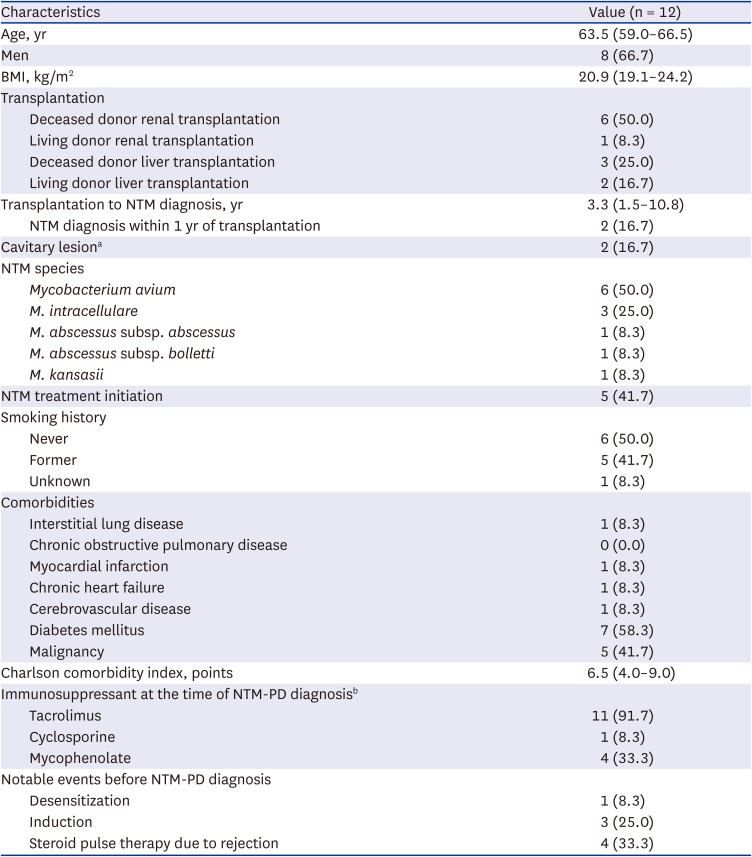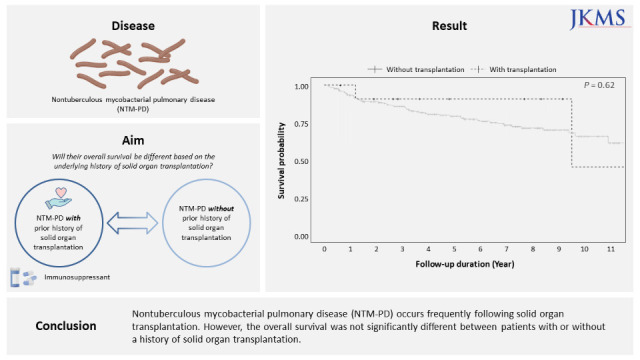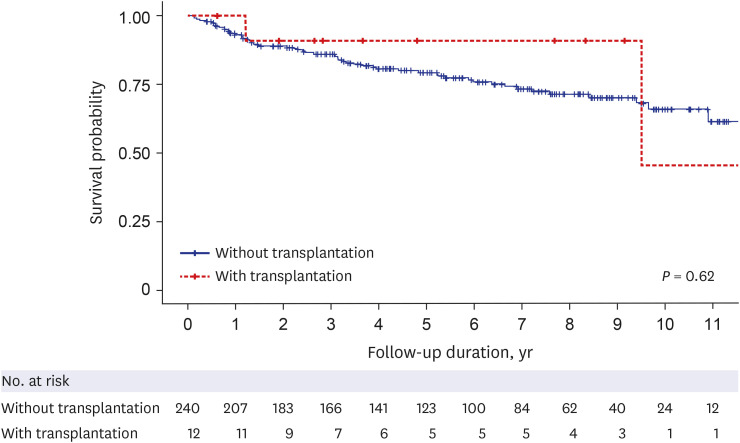1. Griffith DE, Aksamit T, Brown-Elliott BA, Catanzaro A, Daley C, Gordin F, et al. An official ATS/IDSA statement: diagnosis, treatment, and prevention of nontuberculous mycobacterial diseases. Am J Respir Crit Care Med. 2007; 175(4):367–416. PMID:
17277290.

2. Koh WJ, Chang B, Jeong BH, Jeon K, Kim SY, Lee NY, et al. Increasing recovery of nontuberculous mycobacteria from respiratory specimens over a 10-year period in a tertiary referral hospital in South Korea. Tuberc Respir Dis. 2013; 75(5):199–204.

3. Lee H, Myung W, Koh WJ, Moon SM, Jhun BW. Epidemiology of nontuberculous mycobacterial infection, South Korea, 2007-2016. Emerg Infect Dis. 2019; 25(3):569–572. PMID:
30789139.

4. Park YS, Lee CH, Lee SM, Yang SC, Yoo CG, Kim YW, et al. Rapid increase of non-tuberculous mycobacterial lung diseases at a tertiary referral hospital in South Korea. Int J Tuberc Lung Dis. 2010; 14(8):1069–1071. PMID:
20626955.
7. Longworth SA, Daly JS. AST Infectious Diseases Community of Practice. Management of infections due to nontuberculous mycobacteria in solid organ transplant recipients-guidelines from the American Society of Transplantation Infectious Diseases Community of Practice. Clin Transplant. 2019; 33(9):e13588. PMID:
31077618.

8. Knoll BM, Kappagoda S, Gill RR, Goldberg HJ, Boyle K, Baden LR, et al. Non-tuberculous mycobacterial infection among lung transplant recipients: a 15-year cohort study. Transpl Infect Dis. 2012; 14(5):452–460. PMID:
22676720.

9. Daley CL, Iaccarino JM, Lange C, Cambau E, Wallace RJ Jr, Andrejak C, et al. Treatment of nontuberculous mycobacterial pulmonary disease: an official ATS/ERS/ESCMID/IDSA clinical practice guideline. Clin Infect Dis. 2020; 71(4):905–913. PMID:
32797222.

10. Hwang JA, Kim S, Jo KW, Shim TS. Natural history of
Mycobacterium avium complex lung disease in untreated patients with stable course. Eur Respir J. 2017; 49(3):1600537. PMID:
28275170.
11. Jo KW, Park YE, Chong YP, Shim TS. Spontaneous sputum conversion and reversion in
Mycobacterium abscessus complex lung disease. PLoS One. 2020; 15(4):e0232161. PMID:
32339194.
12. Moon SM, Jhun BW, Baek SY, Kim S, Jeon K, Ko RE, et al. Long-term natural history of non-cavitary nodular bronchiectatic nontuberculous mycobacterial pulmonary disease. Respir Med. 2019; 151:1–7. PMID:
31047103.

13. Park Y, Kim CY, Park MS, Kim YS, Chang J, Kang YA. Age- and sex-related characteristics of the increasing trend of nontuberculous mycobacteria pulmonary disease in a tertiary hospital in South Korea from 2006 to 2016. Korean J Intern Med. 2020; 35(6):1424–1431. PMID:
32550717.

14. Park SC, Kang MJ, Han CH, Lee SM, Kim CJ, Lee JM, et al. Prevalence, incidence, and mortality of nontuberculous mycobacterial infection in Korea: a nationwide population-based study. BMC Pulm Med. 2019; 19(1):140. PMID:
31370826.

15. Patel R, Paya CV. Infections in solid-organ transplant recipients. Clin Microbiol Rev. 1997; 10(1):86–124. PMID:
8993860.

16. Doucette K, Fishman JA. Nontuberculous mycobacterial infection in hematopoietic stem cell and solid organ transplant recipients. Clin Infect Dis. 2004; 38(10):1428–1439. PMID:
15156482.

17. Lloveras J, Peterson PK, Simmons RL, Najarian JS. Mycobacterial infections in renal transplant recipients. Seven cases and a review of the literature. Arch Intern Med. 1982; 142(5):888–892. PMID:
7044331.

18. Higgins RS, Kusne S, Reyes J, Yousem S, Gordon R, Van Thiel D, et al. Mycobacterium tuberculosis after liver transplantation: management and guidelines for prevention. Clin Transplant. 1992; 6(2):81–90.







 PDF
PDF Citation
Citation Print
Print





 XML Download
XML Download